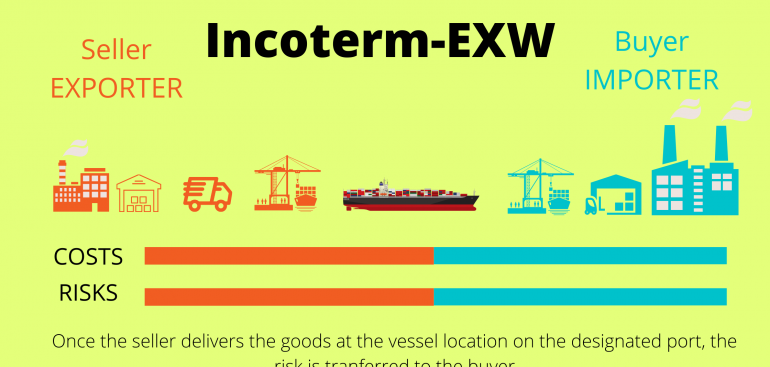There are many delivery terms used in international shipping. Ex-works incoterms are one of them and are frequently used. Delivery terms or incoterms play a crucial role in determining the price of the product.
The word “ex-factory” is simple to explain It means “from the factory.
In this scenario, both parties sign the agreement using an incoterm contract, and the buyer signs a Purchase order.
When the seller has received the Purchase order from the buyer, they begin making goods, and once the product is ready, they package the finished product in accordance with the requirements and store all the finished products in their loading dock.
From now on, all responsibilities rest with the buyer. The buyer put the vehicle in place and then pick up the items.
Negotiation:
The buyer will send a ‘Request for quotation’ to the seller and issue a quotation.
Let’s suppose that the seller has provided the quote that includes transport of the goods to the destination port, with insurance coverage. This is also known as CIF delivery.
However, buyers noticed per unit costs are excessive, and when they looked at the prices, they found that cost of goods is acceptable for them, but freight and insurance charges are too expensive.
They speak to local freight forwarders and receive the quote for the charges for work exempt as well as Freight charges. They discovered that the local freight forwarders were cheaper than those quoted by the seller.
Then they return to the seller to inform them they would like the price of ex-works and ask for a revised quote Seller revised their quote and then they present an ex-works quote and the same is approved by the buyer. The buyer issues a Purchase Order.
Final goods:
When the Purchase order is approved, the Seller reviews the plan and provides a rough date for readiness (Ex-factory day) to the buyer. The seller begins production according to the schedule. When the production is finished, they then pack the final product according to the plan. The packaging can vary in kinds like boxes, bags, pallets, crates, pallets, etc.
In the event of a contract for commodities, milling, processing, and sorting or grading is performed in lieu of production.
After packing is completed after packing, the goods are stored in the warehouse, and the seller provides confirmation of the date at which they left the factory to the buyer.
Operations according to Ex-works incoterm:
After the buyer receives a confirmation of their dates for readiness or the date ex-factory they contact the local freight forwarders to make a container booking. They also provide information about the date of ex-factory and product information, quantities and measurements, etc.
After receiving the details, the freight forwarder should contact their counterpart or agent in their country of origin.
We will briefly discuss agents and counterparts.
Freight forwarders who are in destination countries can’t complete all the ex-works incoterm tasks in their country of origin on their own in an additional country, therefore they require someone from their port or in the country of origin to manage the shipment and organize the clearance process local transportation, container operations and so on.
Certain freight forwarders own their offices in both the destination and origin country whereas some freight forwarders do not have their own offices, however, they are in agreement with freight forwarders from the destination country, who manage all of their operations for them. they are referred to as foreign counterparts or agents of local freight forwarders.
Returning to the former operations of the factory local freight forwarder relays all information to their agent in the overseas area and counterpart. Their agent contacts the seller to ask for the exact date and time of loading.
In parallel, they book containers and even vehicles.
We’ve written an entire article about Container. You can read it by clicking here.
On the day of loading, and overseas, the agent forwards container trucks (as needed) to the seller’s factory and only plans to load products at the specified time, and then the goods are shipped to the port/cfs/icd office to be cleared for custom clearance.
Once custom clearance is completed, the goods are loaded onto the vessel on which slots were reserved by the agent from overseas or the counterpart to the freight forwarder.
Once the vessel is shipped overseas, the agent follows up with the liners and other authorities in the country of origin regarding the post-sealing documents.
Documents are transferred in accordance with the payment time frame agreed upon.
When the vessel arrives at the port of destination, all tasks are managed by the buyers and their designated CHA.
This was the whole procedure for the delivery term Ex-works.

